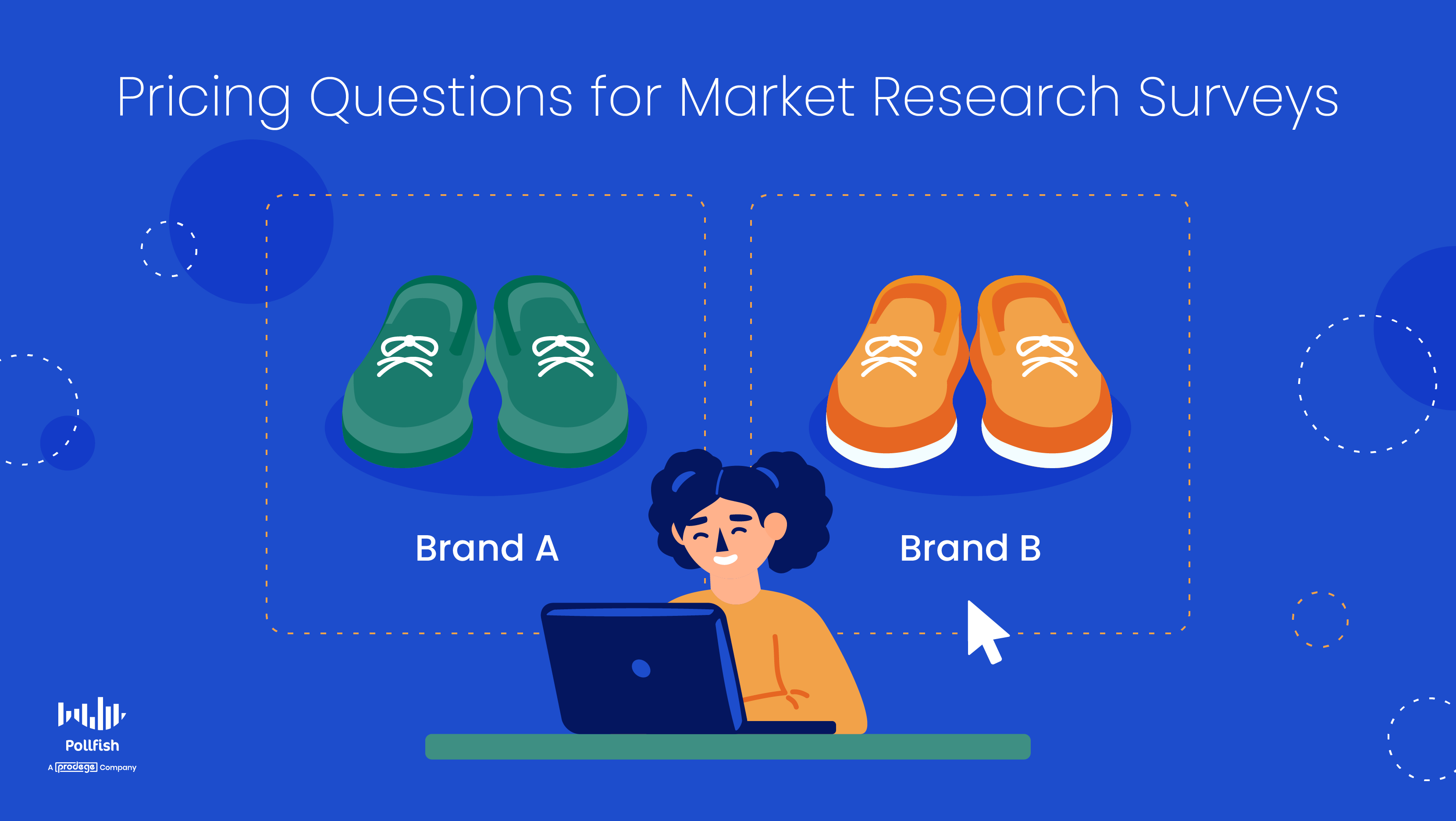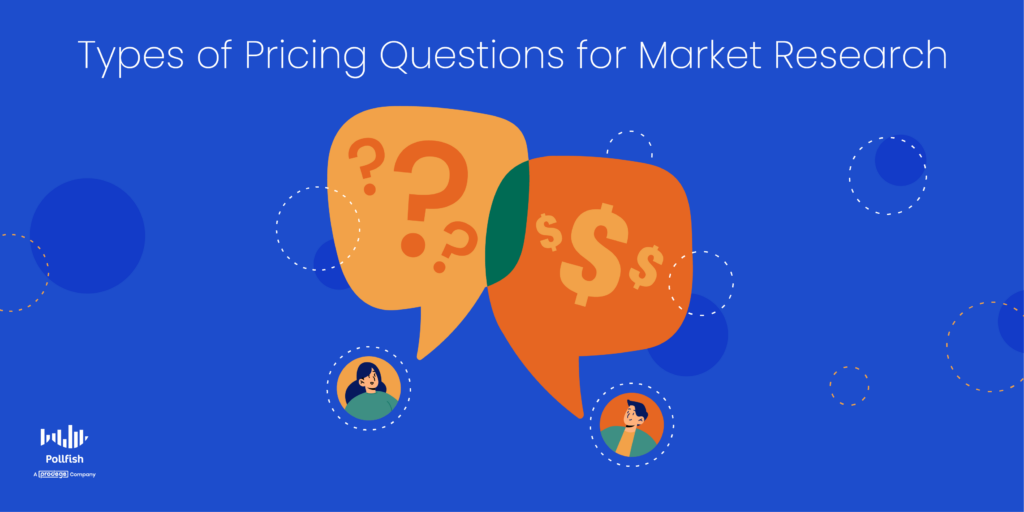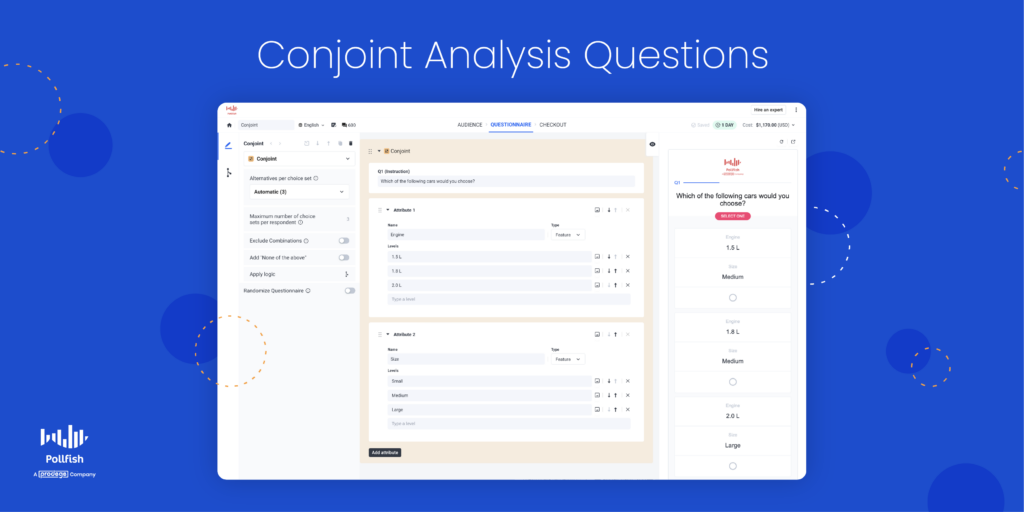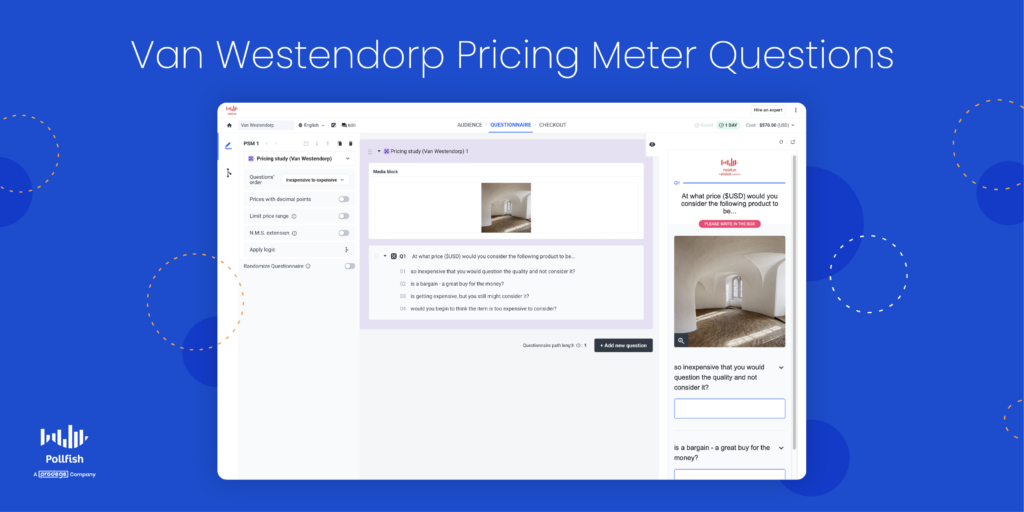The Most Instrumental Pricing Questions for Market Research

You’ll need to use a handy set of pricing questions for market research, specifically for your pricing research campaigns.
These questions are particularly useful in survey studies, as surveys — especially the online variety — are the most effective tools for conducting market research.
Online surveys grant you quick access to the customer behaviors and perceptions of your target market, the segment of customers most likely to buy from you.
As such, you should apply surveys to pricing studies, as the prices of your products and services are highly important to many customers. In fact, a wide swath of customers makes their purchasing decisions solely based on price.
That’s why you’ll need a solid set of pricing questions that you can use in your pricing survey and various other market research campaigns.
This guide lays out a variety of different types of useful pricing questions for market research to use in your pricing survey, including their key examples and importance.
The Importance of Pricing Questions for Market Research
Using pricing questions for market research is exceptionally important in the age of mass information and price-conscious customers.
Presently, a wide swath of customers makes their purchasing decisions solely based on price.
This is the case across virtually all industries.
A whopping 65% of customers check for price comparisons while they’re physically shopping in a store. These comparisons then dictate their buying decisions, given that these price-conscious customers consider the price of a product as a key buying factor.
This is proven, as 57% of consumers consider price to be a top factor in deciding which company to buy from. Clearly, customers are paying attention to the price of your products — and you should too.
You’ll therefore need to have a reliable set of pricing questions in order to run a pricing survey or conduct any sort of pricing research.
It’s always helpful to have a guiding light for your research endeavors, so use this article to find useful pricing questions.
Types of Pricing Questions for Market Research
There are different types of pricing surveys; thus, you’ll find different kinds of pricing questions. Pricing questions can differ in the following ways:
- Differing formats
- Accompanying visualizations
- Question topics
- Question styles (yes or no, more contextual questions, etc.)
In order to conduct a strong pricing research campaign, it’s important to be able to identify the kinds of pricing questions out there, so that you not only understand them better, but can create them on your own and know which to use in different circumstances.

The following lists the four main types of pricing questions you’ll find in different market research campaigns. Some of them may require using a market research tool that supports a particular format and presentation, such as with a conjoint analysis and the Van Westendorp Pricing Meter.
Thus, the types of pricing questions you can create depend on the online survey platform you use. Not all survey platforms offer the same features, so you may not be able to use all of these question types if your online market research platform doesn’t support them.
Here are the four main types of pricing questions for market research:
- Van Westendorp Pricing Meter questions
- Customer Willingness to Pay questions
- Gabor Granger questions
- Conjoint Analysis
Now, let’s explore each question type by understanding it in greater depth and seeing some question examples.
Van Westendorp Pricing Meter Questions
These questions are used with a market research feature called the Van Westendorp Price Sensitivity Meter. This is a pricing model that provides data for decision-making in regard to consumer price preferences.
The meter uses a visualization in the form of a graph, with ratings on price and value. These are presented as responses to survey questions that focus on the prices of different products and services.
As such, it is used to determine customers’ willingness to pay a range of prices. It uses their answers to conclude the prices that your customers deem acceptable, too high, too low and optimal.
As such, this pricing model/feature usually comprises only four questions. They include the following:
- What price would be so low that you start to question this product’s quality?
- Determines: Too cheap
- Alternate question: At what price would you consider the product to be so low that you would feel the quality couldn’t be that good?
- At what price do you think this product is starting to be a bargain?
- Determines: Cheap/ good value
- Alternate question: At what price would you consider the product to be a bargain, aka a great buy for the money?
- At what price does this product begin to seem expensive?
- Determines: Expensive high side
- Alternate question: At what price would you consider the product starting to get expensive, not so much that it is out of the question, but you would have to give some thought to buying it?
- At what price is this product too expensive?
- Determines: Too Expensive
- Alternate question: At what price would you consider the product to be so expensive that you would not consider buying it
Customer Willingness to Pay Questions
This question category is simpler than the previous; it is also more specific, as it simply asks customers to share the actual price that they would pay for a product or service.
Customer Willingness to Pay Question Examples
This survey question can be asked in two ways:
- As an open-ended question, allowing respondents to write in their maximum pay number of choice.
- It may also present respondents with a range of numbers to choose from via a multiple-choice question.
- This can be either a single selection question, in which responders choose one price or a multiple selection question, where people can select more than one.
Direct and simple, Customer Willingness to Pay questions are therefore easy for researchers to create and for their respondents to answer.
Given that these questions only require participants to state how much they are willing to pay for something, respondents aren’t required to have any background knowledge about a product, nor do they need to have experience using it, or information about its industry.
Although respondents that do possess this background knowledge may have more realistic answers, it isn’t critical.
Although these question types are useful, they lack context. When there is no other information, and you ask about the willingness to pay at one point in time, this question risks getting inaccurate data due to the simple execution of answering.
In addition, respondents may overestimate their own price sensitivity, as they choose their own answers of the prices they themselves desire. These are understandably going to be lower than the actual prices of goods, which they would still buy.
Gabor Granger Questions
These questions use a market research feature called the Gabor Granger Model. This kind of survey feature works by establishing the maximum amount responders are willing to pay for a product or service.
The questions and answers are linked and presented in a flow chart-esque way, where the respondents are shown set price points to determine the highest one they would accept. Then, their responses are used to find the optimal price range for your target customer.
These pricing questions use advanced skip logic to continually move through a set of questions until the highest price point is reached.
Aside from determining the optimum price for your customers, the Gabor Granger model generates a price elasticity curve. This visualization illustrates the effects of raising and lowering the prices demanded, showing you just how the impact of pricing changes has on potential sales.
How it works:
- The initial price is $100; the respondent marks “No.”
- Then, $70 is shown; the respondent marks “Yes.”
- Then, $80 is shown: the respondent marks “No”
- Then, $75 is shown: the respondent marks “No.” -At this point, the question is complete, as $75 is found to be the highest price point.
This model is especially ideal in the following two scenarios:
- You already have a price range, but would like to sharpen it for accuracy
- You seek to learn the price sensitivity of your product in your industry.
Gabor Granger Question Examples
Here are some Gabor Granger question examples:
- If we changed our streaming service to include unlimited movies, how would you evaluate the following price points:
- Pricing Option: $50 per month
- Answers: Yes, No
- If we offer certain upgrades for a new rent increase, how would you evaluate the following rent raise price:
- Pricing Option: $100 more per month
- Answers: Yes, No
- What is the probability that you would buy this product at $400?
- Pricing Option: $400 (initial)
- Answers: Rating scale of 1-7, (1= not likely, 7 = highly likely)
- If we offered this product in a bundle, how would you evaluate the following price points:
- Pricing Option: $45
- Answers: Yes, No
Conjoint Analysis Questions
A conjoint analysis is another specialized market research feature. It allows researchers to measure the value that consumers place on various aspects of a product or service.
As such, it is used when you have other variables aside from price to evaluate, such as when you decide which features to include in a product, or which services to include in an offer to customers.
A conjoint analysis presents respondents with a series of configurations, with different price points, and asks them to choose their desired prices. These arrangements can be randomized as well, allowing you to see the trade-offs customers are willing to make.
Thus, it shows how your customers perceive the makeup of your offerings, in relation to the price.
This method breaks a product or service down by its various components, called attributes and levels. Researchers can test different combinations of the components to identify consumer preferences.
Although this is one of the most complex pricing models, it is also the most accurate. A strong online survey platform, however, will make it easy to run this model, as it can be used as another survey question.

The Two Types of Conjoint Analysis Features on Pollfish
- Choice-Based/Discrete-Choice Conjoint Analysis:
- Users are asked to choose repeatedly from a set of 3-5 full profile concepts. It’s designed to mimic real-world shopping behavior by presenting two complete offerings side by side. The data is then analyzed to identify the preference for different attributes and features based on the trade-offs the user made when making their choices.
- Maxdiff Conjoint Analysis:
- Also called the Best-Worst Scale, a Maxdiff Analysis is a mechanism for prioritizing new product ideas and tailoring them to consumer preferences.
- This is a kind of conjoint analysis that helps brands determine the value that their customers place on different parts and features of a product.
- Respondents choose the best and the worst option from a given set of options, which relate to a product and its feature(s).
- Respondents rate a list of items by selecting only two of them — the complete opposite of each other, labeling one as the best of the list and one as the worst.
- This technique helps to identify what your target market values and what it despises.
- Users are shown a series of packages and asked to choose the best/most preferred and worst/least preferred. It’s designed to cut out the ‘middle ground’ and focus respondents on the best and worst items in a list, requiring less effort on their part.
Conjoint Analysis Question Examples
Choice-Based Conjoint Analysis Questions
- Which of the following smartphones would you buy for $700?
- Pricing Option: A single product
- Answers: DIfferent phone attributes
- If we offered a new kind of sneaker, which of the following options would be most appealing to you? Please make one choice per set. If no options look appealing, choose “None.”
- Pricing Option: 3-4 prices
- Answers: Different styles, brands and price points
MaxDiff Conjoint Analysis Questions
- When choosing a price point for a resort, what are the least and most important factors in your decision?
- Pricing Option: Most important, least important fill-in options
- Answers: Pool availability, Gym availability, Suite availability, Price
- Which are the most unlikely and likely prices that would make you buy this product?
- Pricing Option: Various price points
- Answers: Respondents choose 2: 1 very unlikely price and 1 very likely in a set of price options
Setting the Right Prices
Setting the right prices for different products and services can be tricky, but it shouldn’t be an ordeal — not with the proper survey platform, that is.
The key to mastering price research campaigns is to use a strong online survey platform, as not all market research platforms offer the same capabilities, features and customer support.
Use an online market research platform that allows you to easily target your survey audience, create your questionnaire and deploy it to the masses (or to specific people).
Luckily, Pollfish facilitates all three of these critical aspects in the survey creation and distribution process.
We offer two methods of survey distribution: deploying surveys across a large network of random internet users in their natural digital environments via our Random Device Engagement (RDE) method, as well as the option to target specific customers in specific online spaces with the Distribution Link feature.
Additionally, Pollfish survey software allows you to create and analyze a thorough survey data collection, one you can customize, view and organize however you like.
In addition, with our vast array of question types, you can create virtually any type of pricing research survey to support your market research campaign.
You can also leverage a wide range of information on your respondents by accessing a wide pool of insights in your survey results dashboard.
With a market research platform this advanced, you can easily create a pricing survey and conduct data-driven pricing research campaigns to win over all of your customers.
Pollfish Marketing Team
Ready to Try Pollfish?
Create your survey with AI, target high-quality respondents starting at $0.95 per complete, and start getting results in just minutes in real-time. From running a simple product concept survey to managing a constant stream of trackers for dozens of clients in dozens of countries, we’ve got you.

